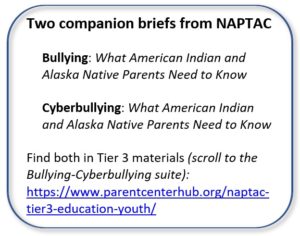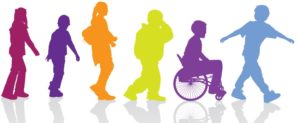2nd edition, March 2020
A publication of the Native American Parent Technical Assistance Center (NAPTAC)
Compiled by Joann Sebastian Morris for NAPTAC
- Download this resource list in Word (77 kb)
- Download this resource list as a PDF (219 kb)
- Visit the Native American Resource Collection
This resource list has been compiled expressly for Parent Centers and the Native families and communities they serve. You can use the list to connect with agencies and organizations, publications, bullying prevention programs, and websites that address bullying and cyberbullying.
__________________
 Quick-Jump Links to Types of Resources Listed Below
Quick-Jump Links to Types of Resources Listed Below
- Agencies and organizations addressing bullying
- Bullying prevention programs
- Publications on bullying
- Websites about bullying
- Organizations addressing cyberbullying
- Publications on cyberbullying
- Websites about cyberbullying
___________________________
Agencies and Organizations Addressing Bullying
Indian Health Service (IHS) | This office in the U. S. Department of Health & Human Services sponsors a bullying prevention campaign: Stand Up Stand Strong. Fact sheets, brochures, and posters are available, as well as a link to a video with Native youth. Online at:
https://www.ihs.gov/dbh/resources
Office for Civil Rights (OCR) | This is an office in the U. S. Department of Education. OCR investigates complaints that a student’s civil rights have been violated, due to discrimination based on a youth’s race, ethnicity, national origin, gender, religion, or disability. Online at:
http://www2.ed.gov/about/offices/list/ocr/complaintintro.html
PACER’s National Bullying Prevention Center | PACER is a parent training and information center that supports and advocates for children with disabilities and their families. Its national Bullying Prevention Center provides resources that benefit all youth, including those with disabilities. Parents can find workshops and other resources on their website. They’ve also created separate resources for kids and teens. Online at:
http://www.pacer.org/bullying/
Substance Abuse and Mental Health Services Administration (SAMHSA) | This federal agency supports a Tribal Training and Technical Assistance Center that makes available a fact sheet called Bullying Prevention in Indian Country, two webinars on bullying (scroll down the page until you reach “Bullying Prevention”), and a new free KnowBullying app for all smartphones.
Bullying Prevention Programs
Connect for Respect | This initiative of the National Parent-Teachers Association (PTA) helps parents, youth, and educators prevent bullying and create safe schools. Online at: http://www.pta.org/bullying
Not in Our Town (NIOT)/Not in Our School (NIOS) | NIOT is a program to stop hate and racism, and build inclusive communities. NIOS addresses student bullying by building safe and inclusive school environments. NIOS offers trainings, films, lesson plans and other resources.
Online at: http://www.niot.org/nios
Olweus Bullying Prevention Program | This is the oldest evidence-based program to prevent bullying in schools and improve school climate. It includes school-wide elements, classroom-level activities, and individual interventions for youth identified as bullies.
Online at: https://www.olweus.sites.clemson.edu
Positive Behavioral Interventions and Supports (PBIS) | PBIS is a well-researched, three-pronged strategy that focuses on the prevention of youth behavior problems while promoting a positive, collaborative school/group environment.
Online at: https://www.pbis.org
Second Step | This is the flagship program of the Committee for Children. Second Step is a research-based social-emotional learning program that infuses bullying prevention while pre-K to grade 8 students learn to manage their emotions, form healthy relationships, make good decisions, and cope with challenges.
Online at: https://secondstep.org
Publications on Bullying
A Sweetgrass Method of bullying prevention for Native American youth
The Sweetgrass Method incorporates traditional Native values, involves elders and traditional practitioners, and includes Native stories, songs, and teachings. By Mark Standing Eagle Baez and Patricia Isaac (2013), the article is published in the Journal of Indigenous Research, Volume 3, Issue 1, Article 1.
Online as a PDF file (501 kb), at: https://digitalcommons.usu.edu/kicjir/vol3/iss1/1/
Bullying prevention in schools starts with social-emotional learning
This 9-page paper notes that bullying prevention requires a multi-pronged approach. The school needs appropriate policies. Staff need training in bullying prevention, and due to the social nature of bullying, students need social-emotional competence. Online as a PDF (244.4 kb), at:
https://www.cfchildren.org/wp-content/uploads/programs/docs/Second-Step_White-Paper_SEL-is-the-foundation-of-bullying-prevention_FA18.pdf
Parent fact sheet: What are public schools required to do when students with disabilities are bullied?
From the U. S. Department of Education (2014).
https://www2.ed.gov/about/offices/list/ocr/docs/dcl-factsheet-bullying-201410.pdf

Walk a mile in their shoes: Bullying and the child with special needs
This parent-friendly report includes chapters on what parents should know about: bullying, cyberbullying, how to address bullying, and parents’ rights. Online as a PDF (3.8 MB), at: http://abilitypath.org/wp-content/uploads/2015/11/walk-a-mile-in-their-shoes.pdf
Websites About Bullying
http://stopbullying.gov | This is the Federal Government’s bullying prevention website, managed by the U. S. Department of Health and Human Services. It includes the most up-to-date information from multiple researchers, partnering groups, and agencies. Tip sheets for parents, including parents of youth with disabilities and special health needs, are available. The website also provides activities designed by and for youth to address bullying and cyberbullying behaviors, and an online training course for educators and other adults.
https://wernative.org | This website was created by the Northwest Portland Area Indian Health Board in 2012 as a multimedia health resource for Native youth, by Native youth. It has a particular focus on the prevention of bullying, substance use and suicide.
Organizations Addressing Cyberbullying
Cyberbullying Research Center | This research center is highly respected for providing the latest bullying and cyberbullying facts and statistics, along with a wealth of resources. Included are tip sheets for parents, youth and educators; activities; and presentations, such as a webinar about the bullying of youth with Autism Spectrum Disorder. The two founders have authored five books on cyberbullying.
Online at: http://cyberbullying.org
Family Online Safety Institute | This international non-profit organization works to make the online world safer for kids and their families. It provides resources on good digital parenting, including videos and a toolkit.
Online at: http://fosi.org
Publications on Cyberbullying
Cyberbullying | This online article can be read or listened to using Read/Speaker. It opens with the definition of cyberbullying and its negative consequences. The balance of the article advises teens what they can do about cyberbullying. Online at:
http://kidshealth.org/en/teens/cyberbullying.html
Information and resources to curb the growing problem of cyberbullying
Read and share the National Crime Prevention Council’s collection of short, easy-to-read publications on cyberbullying, including FAQs for parents, FAQs for teens, and six podcasts. Online, starting at: http://www.ncpc.org/resources/cyberbullying
Teen Sexting: A brief guide for educators and parents
By cyberbullying researchers, Sameer Hinduja and Justin W. Patchin, this 8-page 2018 guide offers the latest data on teen sexting. It provides practical advice for parents and educators to change teens’ minds about what’s acceptable and unacceptable, to increase self-respect, and to protect them from peer and societal pressures. Online as a PDF (2.65 MB), at: http://cyberbullying.org/sexting-research-summary.pdf
Websites about Cyberbullying
http://www.commonsensemedia.org | The website focuses on age-based ratings of movies and TV shows so parents can make good media choices. It also includes 18 resources about cyberbullying and 3 resources specific to sexting. A free curriculum on digital citizenship is available from their partner organization Common Sense Education.
http://www.connectsafely.org | This website offers free booklets written by parents for parents. They include A Parents’ Guide to Cyberbullying, A Parent’s Guide to Instagram, A Parent’s Guide to Snapchat, and downloadable guides on 12 other online safety topics.
https://www.consumer.ftc.gov/topics/protecting-kids-online | At the U. S. Federal Trade Commission’s website, a parent can download free, valuable resources on topics such as: cyberbullying, kids’ texting and sexting, and parental controls.
https://www.missingkids.org/netsmartz/resources | This website is an online safety education project of the National Center for Missing and Exploited Children. It provides free, age-appropriate media presentations and activities to help tweens and teens be safe online. At least 10 downloadable tip sheets for parents are available, such as Parents’ Guide to Smartphone Safety and Gaming Safely.
_______________
Which part of the NAPTAC Library would you like to visit now?
Return to the NAPTAC library’s landing page
Tier 1: Native Culture and Background
Tier 2: Outreach to Native Communities
Tier 3: Native Children and Youth (Go back there now.)
Tier 4: Additional Resources (Coming soon)

